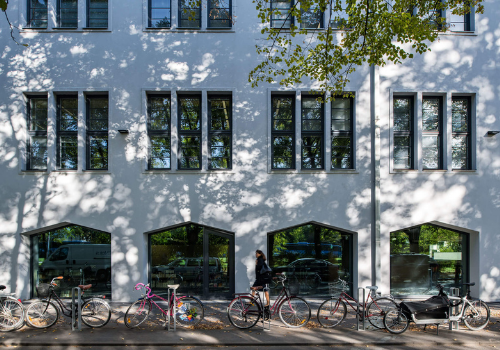For art lovers, the city of Tallinn is a dream destination where the next inspiration is just around the corner. The 2011 European Capital of Culture is home to over 40 art galleries and museums, reflecting its dazzling history at the confluence of cultures on the Baltic sea. The same features form the backbone of the Estonian Academy of Arts (EKA), one of Europe’s most exciting art universities offering an international and multi-dimensional approach to learning.
Nesli Hazal Akbulut is a successful testament of EKA’s catalytic role in nurturing the artistic expression of its students. “I came across the MA in Interaction Design in 2017 and applied without hesitation,” she says. “I knew that this place would provide a safe space with enough limitations and guidance to help me become the designer that I needed to be.”
Her instincts paid off when she graduated from the programme after a smashing exhibition of her master’s thesis, which was shortlisted for the Interaction Design Awards 2020. Akbulut’s EKA journey did not end there. “Thanks to the background that my MA graduation project equipped me with, I became a PhD student at the academy,” she says. The Istanbul native is now a visiting lecturer at the university, becoming an integral part of the Interaction Design faculty, where she has developed a new curriculum since the 2019-20 academic year.
Akbulut’s experience is part of how EKA has managed to capitalise on Tallinn’s reputation as one of Europe’s hotspots for contemporary art and design. Surrounded by futuristic galleries such as the Kai Art Centre, a former secret submarine warehouse, and Kumu Art Museum at the historic grounds of the Kadriorg Palace, EKA knows that thought-provoking ideas translate into innovative artistic practice with the right balance of guidance and experimentation for its students.

Programmes such as the Master of Contemporary Art (MACA) and Master of Urban Studies not only combine transdisciplinary theories and practice, they also draw heavily from Tallinn’s geography to reconceptualise prevailing assumptions and understandings in both fields. True to contemporary art’s ethos in pushing boundaries, MACA students have the freedom to design their own curriculum in a critical discursive environment.
“Apart from getting to know Estonians, which was the greatest highlight, I experienced a great sense of freedom when it came to what I was allowed and able to do during my time at EKA,” highlights Jan Christoffer Rutström from Sweden, who graduated from the programme. EKA’s partnerships with renowned galleries such as the Estonian Contemporary Art Museum and Tallinn Art Hall afford students the opportunity to exhibit their work to a larger audience.
On campus, students fully reap the benefits of studying in an award-winning building equipped with modern workshops, studios and labs to hone their design skills hands-on. With eight master’s and two PhD programmes taught fully in English, EKA’s global appeal is bolstered by the strength of its faculty. The 1,200 students presently enrolled at the university are taught by more than 300 professors, associate professors, instructors and lecturers who are internationally-recognised in their respective fields. This low student-to-professor ratio ensures a highly personalised classroom instruction that is crucial to mastering intricate artistic techniques requiring exceptional technical competence.
One such programme is the Design and Crafts MA, which offers seven specialisations to its students, ranging from jewellery and blacksmithing to textile design. Students get to create products from their chosen medium hands-on in a cross-disciplinary practice that fuses material-based art with new design philosophies.
.jpg)
“My favourite modules are the cross-discipline subjects,” says Amie Chan Nga Man, who graduated with a Design and Crafts MA (Ceramics) in 2021. The Young Applied Artist Award Winner at EKA’s annual TASE exhibition for graduating students captivated the faculty with her project of using Narva, a city at the Russian-Estonian border, as a site of interrogation to explore contested ideas of rootlessness, immigration and geopolitics in experimental art. A Hong Kong-born artist, the theme of uncertainty and instability as an arts practitioner figure prominently in her work. Fortunately, Chan is armed with the right knowledge to pave her own path post-graduation in non-traditional careers. “The courses I attended trained me into an artist who can adapt in a rapidly changing environment,” she says.
.jpg)
For those who aspire to design their signature typeface or animate their own film, EKA provides comprehensive MA degrees in Graphic Design and Animation. The faculty takes a novel and expanded view of graphic design, where students create a body of work in examining the relationship between form, content and production while engaging meaningfully with current cultural contexts. The animation programme has also integrated thorough CGI courses alongside 2D and stop motion techniques in filmmaking. Recently, EKA even hosted the inaugural 2021 International Animation Festival Animist Tallinn, a new annual festival bringing the best animation filmmakers and enthusiasts in multiple screenings, workshops and lectures.
With so much to offer and explore at Tallinn, do you need to learn Estonian to fully navigate life as an international student at EKA? Not necessarily, if you are planning to enrol in its English programmes. Still, it won’t hurt to learn a sentence or two, according to former animation student Pablo Martínez Ballarín. “Take a chance to learn the local language,” he advises. “Use the local and school libraries to get to know art and artists that might be unknown in your country of origin. And ask locals about that, too.”
If you’re ready to embark on a postgraduate journey to refine your artistic knowledge, make EKA your next stop to unlock the artist you were meant to be. The university’s playful character and unique location provide endless reserves for creative freedom, a necessary tool for artists to develop their own artistic message.
Source: Studyinternational.com
Follow the Estonian Academy of the Arts on Facebook, Instagram, Vimeo, Flickr and YouTube.
